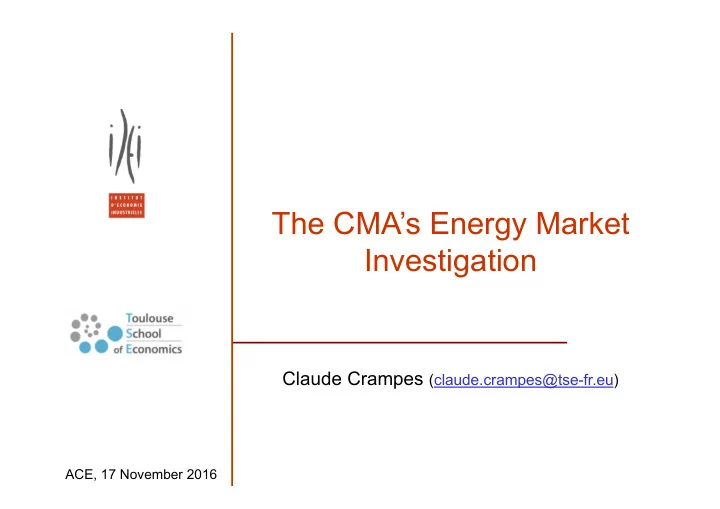

The CMA’s Energy Market Investigation Claude Crampes (claude.crampes@tse-fr.eu) ACE, 17 November 2016
Unconventional outcome • In June 2014, Ofgem referred the energy market to the CMA for a full competition investigation. • CMA published its report two years later. For once in an investigation on potential Adverse Effects on Competition (AEC), the guilty parties are not among the usual suspects: – energy retailers have abused their local market power, but not that much, and without any sign of collusion; – weak competition is mainly due to • lethargic consumers • clumsy regulation CC/ACE 2
The initial roadmap • CMA suggested four (later updated to 5) candidate theories of harm that could explain how certain market characteristics may affect competition and lead to possible adverse outcomes: 1. the market rules and regulatory framework distort competition and lead to inefficiencies in wholesale electricity markets; 2. market power in electricity generation leads to higher prices; CC/ACE 3
Theory of harms 3a. opaque prices and low liquidity in wholesale electricity markets distort competition in retail and generation. 3b. vertically integrated electricity companies act to harm the competitive position of non-integrated firms to the detriment of the consumer, either by increasing the costs of non-integrated energy suppliers or reducing the sales of non-integrated generating companies. 4. energy suppliers face weak incentives to compete on price and non-price factors in retail markets, due in particular to inactive customers, supplier behaviour and/or regulatory interventions. 5. the broader regulatory framework acts as a barrier to pro- competitive innovation and change. CC/ACE 4
Remedies • facilitate price comparisons • price cap for customers on prepayment meters; • creation of a database of the customers who have been on their existing supplier’s default tariff for at least three years; • removal of Ofgem’s measures that limit the ability of suppliers to compete (number and format of tariffs, ban of price discrimination); • clarification of Ofgem’s objectives and duties CC/ACE 5
The original paradigm Competition authority (CMA, …) Retail market Wholesale market Production Consumers Transmission Distribution Supply Regulatory agency (Ofgem, …) CC/ACE 6
Independent economic regulators • “Because of the technical nature of electricity and gas production and distribution, energy markets are highly regulated, and the nature of competition in these markets is shaped by the design of the regulatory regime to a much greater extent than in most other markets. ” (CMA, p. 1219) • “ The broad rationale for the creation of independent economic regulators in privatised sectors of the economy is to provide greater certainty to potential investors that they will have a reasonable opportunity to earn a return on their investments if they operate efficiently .” (CMA, p. 1228) CC/ACE 7
Why is Ofgem monitoring the retail market? • “ Ofgem’s principal objective is to protect the interests of existing and future consumers in relation to gas and electricity supply. The interests of consumers are taken as a whole, including their interests in the reduction of greenhouse gasses and in the security of supply .” (CMA p.102) • Promoting competition is not an explicit objective for Ofgem, but a priority tool: the Ofgem’s duty is to pursue its principal objective by ‘wherever appropriate promoting effective competition’ (CMA p. 1226) CC/ACE 8
Consumers’ protection or competition promotion? • Ofgem has expressed concerns with regard to its current objectives and duties, noting that its competition duty had been progressively downrated relative to other duties over the last ten years. • The duty to protect vulnerable customers has motivated the prohibition of regional price discrimination and the restriction of the number of core tariffs. • The price-cap remedy is typically an ex-ante regulation CC/ACE 9
The future of electricity regulation • Are the current structure and regulation of the electricity industry adapted to the will of making it greener, more secure and "poor man's friend" by means of market mechanisms? • What we observe is a permanent flow of repair patches, plasters, dressings and state aids more politically than economically oriented. • More generally, is there a need for specific competition rules in network industries? How do they differ from ex ante regulations? • In Spain the National Authority for Markets and Competition (CNMC) consolidated in 2015 after a merger process that started in late 2013. • The CNMC integrates competition and sectoral regulation authorities. The combined mandate includes competition advocacy and enforcement as well as regulatory supervision in core sectors: energy, telecoms, transport, postal and audiovisual. CC/ACE 10
Recommend
More recommend